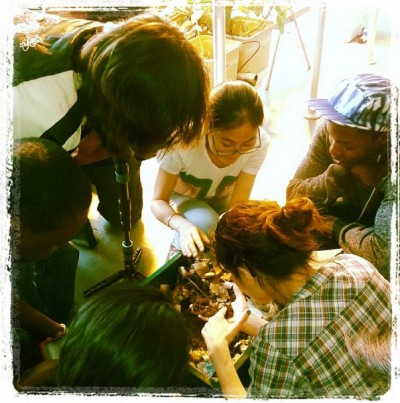
In cities across America, highly dense and (usually) low-income neighborhoods are frequently disadvantaged by the lack of access to affordable and healthy foods – otherwise known as “food deserts.” Chain supermarkets, whose business models typically rely on 30,000 to 100,000 sq ft. stores, find it difficult to invest in urban real estate, especially within low-income neighborhoods that may not be able to guarantee high returns on more expensive food products. Two new projects focus on bringing a range of food choices to these previously neglected areas.
The FARMERY! plans to integrate greenhouses with an attached market, in a compact package that can be sited on a city block. The business would produce and sell locally made food and provide a new and exciting shopping experience. (Prototypes shown here.) The premise: consumers purchase quality foods at affordable prices, learn the true value of the foods they are purchasing through interaction with the growing process, and meet local producers. Designs also include a café that will offer a salad bar, hot bar, coffee and juice bar, which will make sure to utilize locally grown ingredients. “The Farmery” began as a Master’s thesis in industrial design, by Ben Greene, the project founder. Greene also served in Iraq as a combat engineer. The team developing the project is based in North Carolina.
 In New York City, an innovative nonprofit educational project called Students for Service (shown at left) has sprung up with similar aims; the project brings fresh greens and the experience of growing them to students, with a program currently using indoor growing systems in classrooms in Bedford Stuyvesant, Brooklyn. Students for Service describes itself as a “community service and service learning initiative,” with the goal of ultimately increasing demand and access for fresh food in underserved areas. Meeting at monthly intervals, teams of older students help teach younger students about agriculture, how to eat a balanced diet, and what to make with the salad greens they’ve grown.
In New York City, an innovative nonprofit educational project called Students for Service (shown at left) has sprung up with similar aims; the project brings fresh greens and the experience of growing them to students, with a program currently using indoor growing systems in classrooms in Bedford Stuyvesant, Brooklyn. Students for Service describes itself as a “community service and service learning initiative,” with the goal of ultimately increasing demand and access for fresh food in underserved areas. Meeting at monthly intervals, teams of older students help teach younger students about agriculture, how to eat a balanced diet, and what to make with the salad greens they’ve grown.
You can see the students in action in one of a series of videos, here:
Where existing supermarkets — or small groceries — may fail to stimulate shoppers to make the right choices, the Farmery concept and the Students for Service classrooms are designed to bring greater connection and value to fresh food. People can view the life-cycles of their produce and hand-pick their own. And an urban farm-to-table model cuts out transportation cost and some associated wastage.
By introducing this model of local farm-in-market into the American urban context, both disadvantaged communities can have improved access to affordable and healthy foods, and local (small) farmers can become more competitive in a market that has been known to handicap them. Maybe soon the first generation of Students for Service farm volunteers will be looking into gaining their own Farmery! franchise in neighborhoods around New York.
The Farmery concept is described beautifully in the video above; for one more perspective on the future of urban farming, see Nathanael Johnson’s excellent piece in Grist about the larger constraints of farming in cities for a primary food supply, as opposed to a complementary fresh food source: “Urban farms won’t feed us, but they just might teach us.”